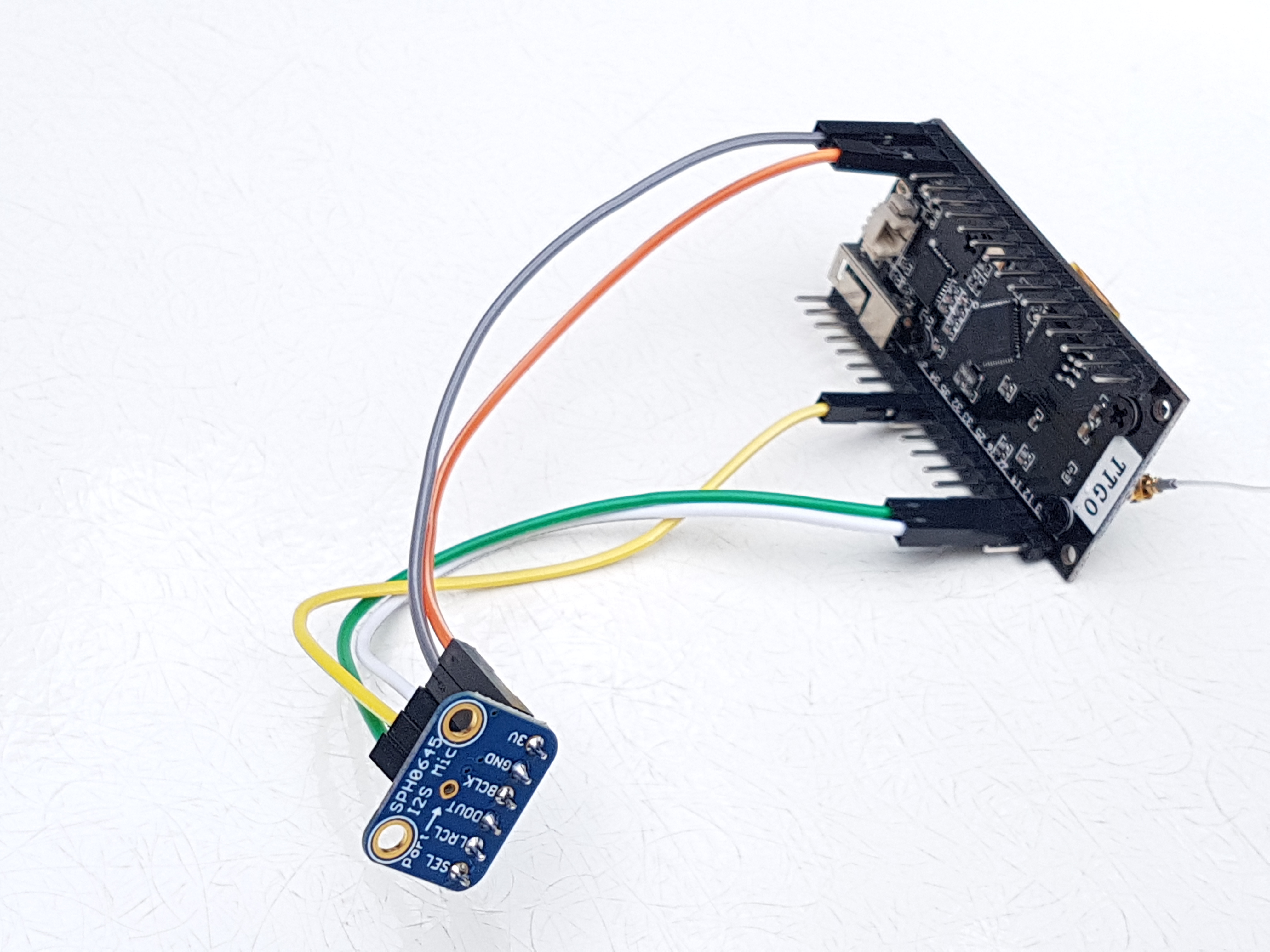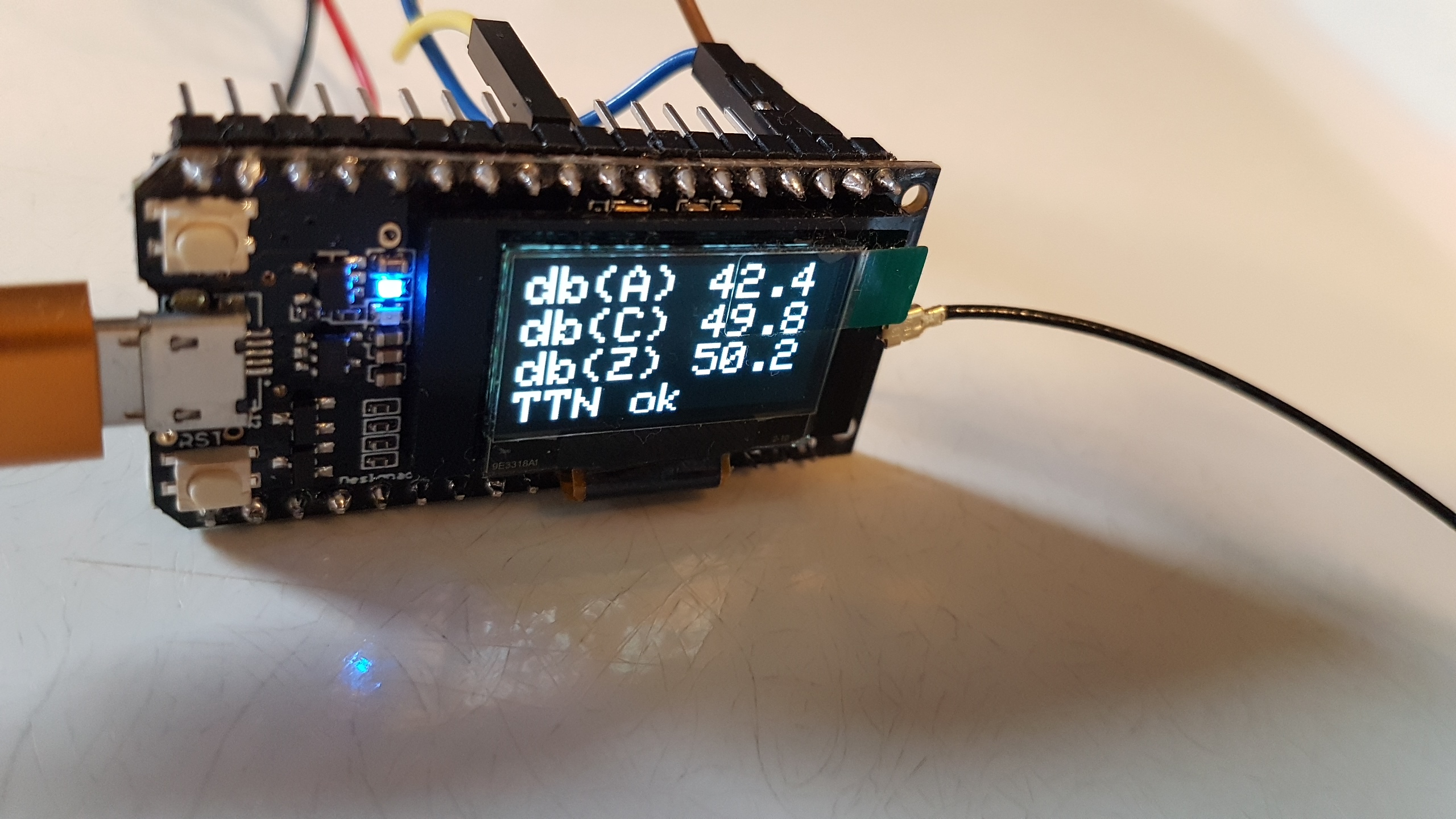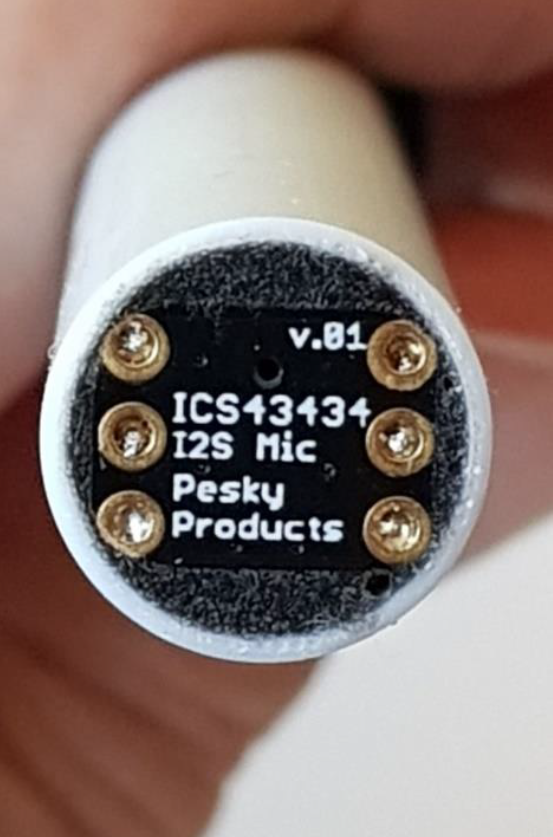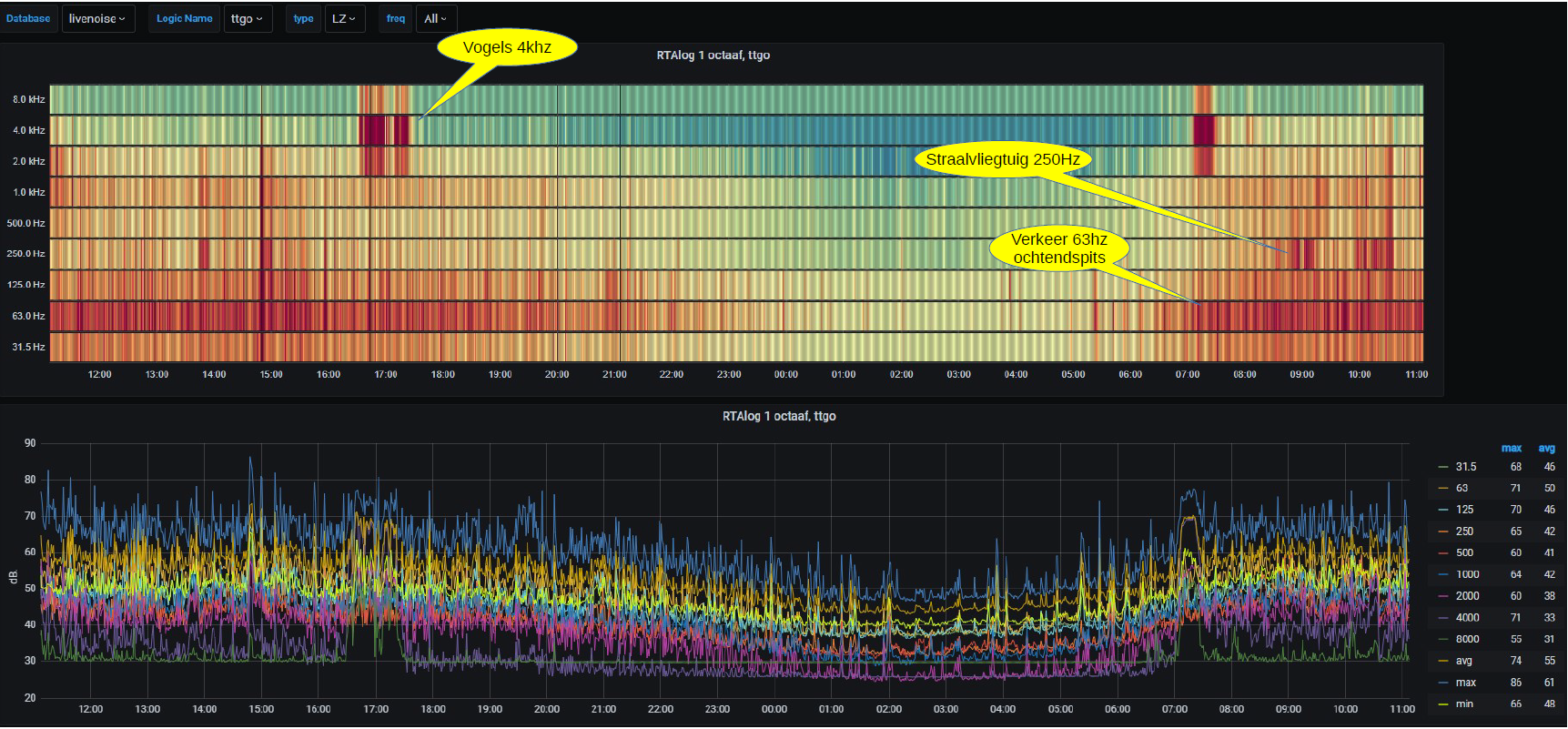- General
- Electronic components assembly
- Board configuration
- Libraries
- Config file
- Specification
- Test Report
- Example graphical output Sound Kit
- Last Updates
- To Do
This Soundkit is easy to build for a low cost price (ca. 35 euro) and is therefore very suitable to be used for citizen sensing.
This sensor measures continuously audible sound by analyzing the data using FFT process. The measured results are send in a report at regular time intervals to the LoRaWan network, where it can be picked up for visualization.
No adjustments are needed, because the sensor uses a digital MEMS microphone. which is factory calibrated. Furthermore it can easily be connected to the community network, viz. it is independent of a home or office network.
The sensor make use of the powerful ESP32 processor, which is a dual core processor. One core handles continuously the processing of audio, while the other core handles the LoRaWan communication.
The sensor measures audible spectrum from 31.5 Hz to 8 kHz divided in 9 octaves. Each regular time interval the average, minimum and maximum levels are calculated for the 3 weighting curves dB(A), dB(C) and db(Z).
Sound Kit TTGO board
Sound Kit TTGO OLED display
Several MEMS microphones can be used, the Soundkit is tested with SPH0645, INMP441 and ICS43434. The ICS43434 is adviced by Sensor.community, because the small headerboard can be assembled in a half inch pipe (13mm) fillled with resin in order to minimize audio resonance. Sound calibrators uses also this diameter size.
ICS43434 in pipe filled with resin
The software is based on TTGO LoRa board, this board includes a ESP32 processor, a Lora RFM95 module, LoRa antenna. The TTGO LoRa board does have an OLED display, and will display the average dB(A), dB(C) and dB(z) levels.
Several MEMS microphones can be connected SPH0645, INMP441 or ICS43434 The SPH0645 was slightly better in low frequencies. This is more important if you want to measure dB(C) and dB(Z) levels. The ICS43434 is better in low levels, less noise.
- Processor board: TTGO LoRa32 V1
- I2S Microphone: SPH0645 or INMP441 or ICS43434
- power adapter 5V, 0.5A
The table below shows the wiring between MEMS microphone (SPH0645 or INMP441 or ICS43434) and the processor board TTGO:
| SPH0645 | INMP441 | ICS43434 | TTGO | |
|---|---|---|---|---|
| 3V | 3V | 3V | <--> | 3V |
| GND | GND | GND | <--> | GND |
| BCLK | SCK | SCK | <--> | GPIO13 |
| DOUT | SD | SD | <--> | GPIO35 |
| LRCL | WS | WS | <--> | GPIO12 |
| LR | LR | GND | ||
| SEL | not connected |
Remark 1:
The length of the wires between MEMS and TTGO-board should not exceed 15 cm and tie the wires close to each other, or use a 5 wire flat cable.
Remark 2
For sound measurements lower then 30 dB, the power to the MEMS microphone must be very clean. The 3.3V supplied to the MEMS can cause some rumble in low frequencies. It can be improved by placing an extra 100nf and 100 uF capacitor in parallel.
PlatformIO Choose your board in the platformio.ini file and change "default_envs" in the line below:
default_envs = ttgo
Arduino Install ESP32 Arduino Core Add the line in Arduino→preferences→Additional Boardsmanagers URL:
https://dl.espressif.com/dl/package_esp32_index.json
Restart Arduino environment. In the Arduino menu Tools→Boards, choose the board TTGO LoRa32-OLED V1
If you develop in PlatformIO, you can skip this section, libraries and macros are defined in platformio.ini and are installed automatically.
There are several LIMC LoRaWan libraries. I use the LMIC library from MCCI-Catena, because this one is currently best maintained. Download the library from https://github.com/mcci-catena/arduino-lmic and put it in your <arduino-path>\libraries\
Take care that you change the frequency plan to Europe (if you are in Europe), because it is defaulted to the US. It can be changed in the file <arduino-path>\arduino-lmic-master\project_config\lmic_project_config.h
#define CFG_eu868 1
For the TTGO board, download the libraries below and put them in your [Arduino-path]\libraries
https://github.com/adafruit/Adafruit_SSD1306
https://github.com/adafruit/Adafruit-GFX-Library
I used the https://www.arduinolibraries.info/libraries/arduino-fft library. The two files “arduinoFFT.h” and arduinoFFT.ccp” are already in your .ino main directory.
In the config.h some parameters are defined.
The cycle count defines how often a measurement is sent to the thingsnetwork in seconds:
#define CYCLETIME 60
For RIVM and sensor.community use 150
Set microphone dependent correction in dB
#define MIC_OFFSET 0.0
for SPH0645 use -1.8
for ICS43434 use 1.5
otherwise use 0.0
TTN V2 stops at the end of 2021, so my advice is use the TTN console V3 to set your keys.
Register your device, choose 'manually' and MAC version 1.03.
Choose activation mode OTAA and copy the the (generated) APPEUI and APPKEY keys into this config file (config,h):
#define APPEUI "0000000000000000"
#define APPKEY "00000000000000000000000000000000"
Note that unique DEVEUI is read from the TTGO ESP32 board id. The DEVEUI is displayed in the TTGO log during startup and is displayed on the OLED display. This value must be entered in the TTN console in the field DEVEUI.
- Accuracy < 1 dB
- sample frequency MEMS microphone 22.628 kHz
- 18 bits per sample
- soundbuffer 2048 samples
- FFT bands in bins of 11 Hz (22628 / 2048)
- measurement cycle time 90 msec
- one measurement contains
- spectrum 31.5Hz, 63Hz, 123Hz, 250Hz, 500 Hz, 1kHz, 2kHz, 4kHz and 8kHz
- average, maximum and minimum level
Every interval time (e.g. each minute) a message is composed from all measurements done in one interval, which contains the following values in dB.
- 9 spectrum levels for dB(A)
- 9 spectrum levels for dB(C)
- 9 spectrum levels for dB(Z)
- min, max, and average levels for dB(A)
- min, max, and average levels for dB(C)
- min, max, and average levels for dB(Z)
The message is send in a compressed binary format to TTN. The TTN payload decoder converts the message to a readable JSON message.
"la": {
"avg": 44.2,
"max": 50.4,
"min": 39.8,
"spectrum": [
22.2,
30.4,
37.1,
36,
35,
35.3,
34.3,
37.4,
30.5
]
},
"lc": {
"avg": 61.3,
"max": 72.5,
"min": 49.5,
"spectrum": [
58.6,
55.8,
53,
44.6,
38.2,
35.3,
33.3,
36.6,
28.6
]
},
"lz": {
"avg": 63.4,
"max": 75.1,
"min": 50.3,
"spectrum": [
61.6,
56.6,
53.2,
44.6,
38.2,
35.3,
33.1,
36.4,
31.6
]
}
}
The report describes three test sets: LoRa TTGO with ICS43434, LoRa TTGO withh SPH0645 and the Teensy4 set of the Sensor Community. The tests are executed with certified class 1 calibrator and soundlevel meter.
Below a heatmap and graph of a sound measurement on my balcony in quiet residential area. The values shown are in dB(Z) In this graph some remarkable items are vissible:
- birds at 4khz at sunrise and sunset
- jet airplane at 250 Hz
- morning rush (traffic) at 63 Hz Note that db(Z) levels shows a lot of noise in low frequencies, which is mostly not vissible in common db(A) measuremnts.
This graph is made with Nodered, InfluxDb and Grafana.
Changed 15-8-2021
- MCCI Catena LoRa stack
- Worker loop changed (hang situation solved with TTN V3)
- OLED display added
- DEVEUI obtained from BoardID, (same SW for multiple sensors)
- use the TWO processor cores of ESP (one core for audio and one core for LoRa)
- DC offset MEMS compensated by moving average window
- payload compressed from 27 to 19 bytes
- test report added
Advice for sensor housing and microphone placement.



